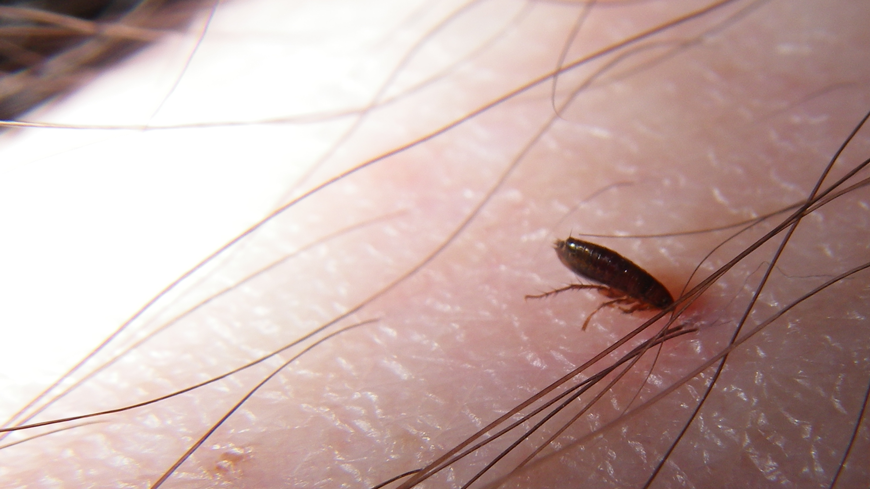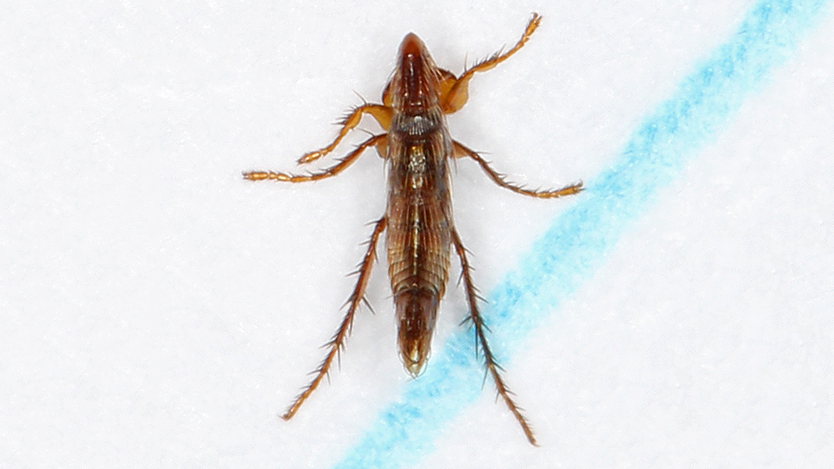
Img 1 An adult cat flea on a human leg. See the length of the leg hair for a size comparison.
Summary
Adult fleas are 1.5 to 3.2 mm long. They’re a dark brown color, with a glossy sheen. Like all insects, fleas have 6 legs and 3 body segments. Their bodies are flattened side-to-side. Dark spines, bristles, and combs cover the body. Fleas have two black, simple (not compound) eyes. They don’t have wings. Flea legs are long and specialized for jumping.
Details
Size
Average Size
Adult cat fleas are 1.5 to 3.2 millimeters in length. Females are the bigger than males, with a larger and heavier abdomens. Females are typically 2.5 mm long, while males may be less a millimeter. Though small, fleas are still visible to the unaided eye. However, the small, thin insects easily slip between hairs near the host’s skin, making them difficult to observe on pets (even those with pure white fur).
Growth
Fleas don’t molt after reaching adulthood. Thus, they can’t grow. However, their abdomens do inflate upon consuming the first blood meal. Unfed fleas’ abdominal segments closely overlap. The segments spread out when they feed. Once fully engorged on host blood, fleas will be double their unfed size. Their maximum size is reached within 48 hours of feeding.
Color & Appearance
Color
Adult fleas are often a dark brown color. They may also appear light brown, reddish-brown, or black. Thanks to their overlapping segments, newly emerged adults are darker than engorged fleas. They’ll appear a lighter brown color once their abdomens swell and spread out.

Img 2 Adult cat fleas have a dark brown-red colored body, with a glossy surface.
Sheen
Fleas have a shiny, glossy appearance. Epidermal glands located at the front of the body excrete an oil-like substance onto the cuticle. The slick coating helps fleas move through host hair.
Sclerotization
Adult fleas have strongly sclerotized and chitinized bodies. As a result, the cuticle is tough. The durable exoskeleton is difficult to rupture. The outer cuticle’s surface is a sculptured pattern, consisting of wavy striations (striae).
The Flea Body
Like all insects, fleas have 6 legs and 3 body segments: Head, thorax, and abdomen. Adults are laterally flattened, appearing as if they’ve been compressed side-to-side Img 2. The flattened body is an adaption which helps them move forward through host fur. Fleas don’t have wings.

Img 3 The compressed body of fleas allow them to easily move through host hair.
Thorax
The thorax consists of 3 segments: Prothorax, mesothorax, and metathorax. The dorsal sclerites (back sections) of the thoracic segments overlap each other. As a result, the segments can squeeze into one another. The mesothorax and metathorax are separated in fleas. As a result, there is no pterothorax, a structure found in most winged insects. The flexible joints of the thorax is an adaption which helps fleas move through a host’s pelage.
Abdomen
Segments
The abdomen consists of 10 segments. Some sources state there are 8 segments, because only 8 are visible. The 3 posterior segments are modified together. Spiracles are on found on each visible segment. Like the thorax, the abdominal segments overlap the following one, and can compress into each other.
Gender Differences
The abdomen’s shape is often used to distinguish between sexes. Female abdomens have rounded dorsal (backside) and ventral (underside) surfaces. Male abdomens have a flatter dorsal surface and a greatly curved ventral surface, giving them an upturned appearance.
Genitals & Sensilium
Genital organs are visible through the cuticle of the last segment. On both sexes, the posterior segment also bears a sensilium. This is a flat plate with numerous circular depressions, each containing a long bristle. The sensilium is a sensory organ which detects air movement, vibrations, and changes in temperature. It plays an important role in host detection.
Head
Size & Shape
Cat fleas have high, narrow head capsules. The shape divides animal hairs during forward movement. The head is rendered immobile by surrounding structures, which also helps protect it while moving through fur.
A sloping, elongate, anteriorly pointed head is the hallmark of cat fleas. In females, the head’s length is double the height. The head is only slightly elongate in males, appearing nearly as tall as it is long.
Eyes
Cat fleas have two small eyes, one on each side of the head. They lie slightly in front of the base of the antennae. Fleas don’t have compound eyes like most insects. Instead, they posses simple eyes, with a single biconvex lens. The eyes are black and round, resembling the dorsal ocelli of other insects.

Img 4 Close up of a cat flea’s head, with visible eyes, antennal fossae, mouth parts, and combs.
Antennae
Short, club-like, three-segmented antennae lie inside deep grooves on either side of the head. The grooves, called antennal fossae, protect the antennae from damage done by moving through host hair. The antennae bear sensory structures, which can detect heat, smell, touch, humidity, and vibrations. Male antennae are longer than females, and are erectable with clasping structures for restraining females during mating.
Mouth Parts
Adult fleas have specialized mouth parts for piercing host skin and sucking blood. Their mouths point downwards into an arrow-like shape.
A channel running along the front of the labium (lower lip) bears a pair of five-segmented sensory palps. Lying inside the labial palps are 3 slender, long stylets. Together, these stylets form a piercing structure called the fascicle. The sharp outer two stylets are called maxillary lacinae, and are used to pierce host skin. The central stylet is called the median epipharynx, and is used to draw blood.
Legs
Flea legs are long and well-adapted for jumping. The hind legs are much longer than the others, and are connected to specialized internal structures for leaping. A highly elastic protein called resilin enables their incredible jumps, not leg muscles.
The coxa (hip) of each leg is relatively large. The trochanter is small and short. The femur is broader than the tibia, but similar in length. The tarsus is divided into 5 tarsomeres. A defining characteristic of cat fleas is that all their legs’ tibiae have 4-5 notches. Strong claws are found at the end of each leg.
Spination
Spines & Bristles
Numerous backwardly directed spines and bristles (setae) cover the thorax, abdomen, legs, and head. The spination helps with forward movement through dense fur, and also prevents reverse travel and easy dislodgement. Fleas get stuck in the haircoat like a cocklebur when a host tries grooming them off. The spines also steady the fleas during feeding, help prevent being being crushed, and protect the membranes between body segments.
Combs
Combs are the most important feature used to identify flea species. The combs consists of rows of stiff, large, black, round-tip spines called ctenidia. They’re heavily sclerotised outgrowths of cuticle, rather than normal setae. Combs are only found on the sides of the head and on the first thoracic segment (prothorax). Similar to the other forms of spination, the ctenidia prevent easy host dislodgement. They also keep the head wedged against host skin during feeding.
Cat fleas have 2 combs—genal and pronotal. The genal combs, located on the sides of the head, contain 7-8 spines. In cat fleas, the 1st and 2nd genal spines are nearly equal in length. The pronotal comb, located on the posterior border of the prothorax, has 7-9 spines on each side (totaling around 16).




You must log in to post a comment. Log in now.